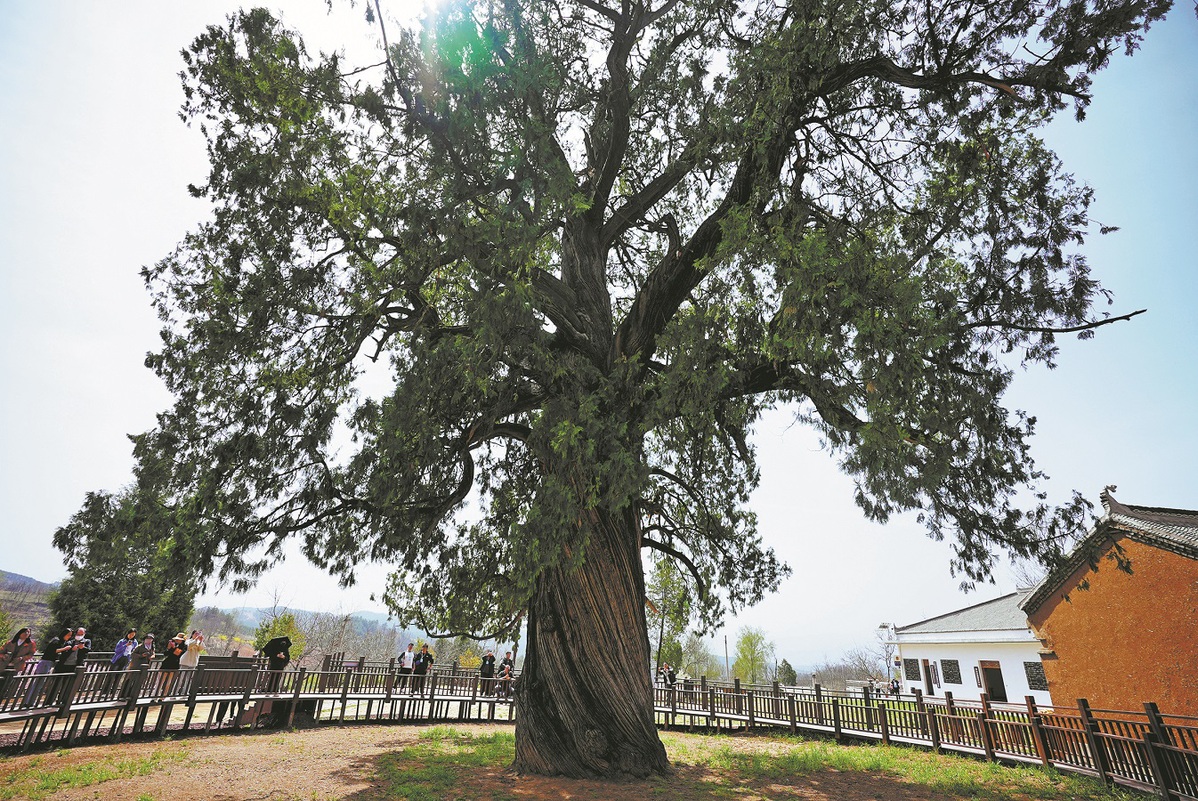5,000-year-old tree a 'living relic'


An ancient tree in Shaanxi province is no longer a lonely watcher; it now participates in modern people's lives. In Bai'an village, Luonan county of Shangluo city, every newborn will be brought under the 5,500-year-old Xueshan Ancient Cypress to "soak in its blessings, hoping they will grow as strong and thriving", said 70-year-old Yao Shuanghuan, a villager. There is a saying that "First came the cypress, then the temple, and only after that, Luonan county".
Towering at 23.17 meters tall with a trunk circumference of 8.2 meters, this colossal tree is seen by the people of Luonan as "living nostalgia" — its official tree registration number, 61102100001, shares the first six digits with local residents' identification cards, earning it the affectionate title of "Citizen No 1".
"We played under this tree as children, and now we've grown old — yet it hasn't changed a bit!" chuckled Meng Zhongjun, a 74-year-old villager who called the ancient tree a "living relic". It has witnessed the village's development and carries precious memories, he said.
Though the ancient cypress now stands with a gnarled and weathered trunk, its foliage remains lush and vibrant throughout the seasons. Its most remarkable feature is the southeastern branch, which resembles a green dragon plunging downward when viewed up close, while from afar, it appears like a phoenix soaring with outstretched wings.
Legend has it that during the Battle of Zhuolu, the Yellow Emperor, or Huangdi, while pursuing the rebel Chiyou, passed by the Luohe River and saw the local people suffer from flooding. The emperor personally planted this cypress to mitigate the disaster. Chinese believe they are descendants of Huangdi. And there is a saying "Falling leaves return to their roots", which conveys the idea of returning to one's origins, especially in old age or death.
During holidays, many tourists come to visit the tree as a way to pay respect to their ancestors.
Now a circular walkway has been built around the tree, and villagers have voluntarily taken on the role of tour guides. Even primary and secondary school students have become guardians of the cypress.
Their daily routine includes meticulous inspection of the tree, monitoring its growing conditions, and clearing debris from its surroundings to ensure an optimal environment. Guardian Zhang Juan's phone holds thousands of photos of the tree. "Daily patrols, weekly documentation, monthly assessments — it's like caring for an elderly family member," she said.
Last summer, the guardian team noticed yellowing in parts of the tree's crown. They immediately reported it. By the next day, experts arrived with equipment and diagnosed a pest infestation. After targeted treatment, the cypress regained its verdant vitality.
The tree has its own digital archive. This comprehensive record documents details such as its species, age, trunk diameter, canopy spread, location and growth condition. He Weinan, director of Luonan's forestry service center, said they used to rely solely on manual inspections for tree conservation.
Today, they employ advanced methods like carbon-14 dating and growth core sampling just to determine age.
"With the archive, staff workers can now monitor the tree's condition in real time, swiftly identifying issues and implementing protective measures," He said.
The second national census of ancient and notable trees revealed that China has more than 5 million such trees. Among these, only five are more than 5,000 years old, all located in Shaanxi, including the Xueshan Ancient Cypress. Zhao Zhong, president of the Qinling Mountains Research Institute of Northwest A&F University, said that the five trees are not only marvels of nature but also treasures imbued with the profound cultural DNA of the Chinese nation.
"From a biological perspective, they rank among Earth's largest living organisms," he said.
- 5,000-year-old tree a 'living relic'
- Ultra-long bonds to be put to use repairing residential elevators
- Youth-driven innovation transforms rural economy
- Railway maintenance underway to ensure safe summer travel rush in China's Taiyuan
- Shenzhen's reforms open up opportunities
- Development zones to drive growth





































